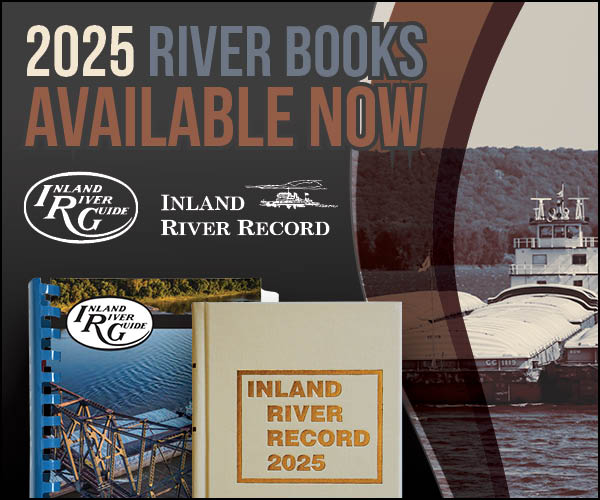Q&A With GICA President Paul Dittman

Paul Dittman has been at the helm of the Gulf Intracoastal Canal Association (GICA) for about a year. He was officially elected president of the association at GICA’s annual seminar in August 2021. A graduate of Massachusetts Maritime Academy, Dittman served in the U.S. Coast Guard from 1991 through 2019, with much of his time spent within the Eighth Coast Guard District. After retiring from the Coast Guard in April 2019, Dittman spent two years as vice president of regulatory compliance for Turn Services, a New Orleans-based provider of fleeting and towing services. The Waterways Journal recently interviewed Dittman to learn more about his first year leading GICA, issues and opportunities facing the Gulf Intracoastal Waterway, and what the future may look like for the GIWW.
WJ: Reflect on your first full year as GICA president. What were some surprises, highlights or challenges?
PD: I was surprised at just how much I learn every day. When I took over the job, I had about 20 years’ experience working along the Gulf Intracoastal Waterway while in the Coast Guard, as well as a couple years working in the private sector. Every day I’m learning something new, particularly about the various portions of the intracoastal and the unique navigation challenges associated with each different section. I’m blessed to have significant reach-back capability, especially with many of the port captains and operations managers with the GICA member companies. I have developed a strong personal and professional relationship with many of them and appreciate all their support over the past year as their new association president. I can honestly say I have grown more personally and professionally in the past year than probably in the previous 10.
WJ: The GIWW is the nation’s third busiest waterway, and the value of products moved on the GIWW can’t be overstated, particularly with regard to energy. How have the economy and inflation impacted operations on the GIWW? And how do current energy prices and supply chain issues underscore the importance of the waterway to the nation?
PD: I would say these current supply chain issues only serve to highlight the value and benefit afforded to the nation by the intracoastal. Through sidebar discussions with many of our association members, I have been told they are operating at capacity. I also know, given these conditions, the potential impacts associated with any unplanned closure or restriction would be increased.
WJ: Less than a month into your tenure as GICA president, the central part of the waterway was hit by Hurricane Ida and, in the midst of that, you had COVID-19. Reflect on that experience.
PD: We lost power, and my wife and I were unable to evacuate because we were in COVID quarantine. It was definitely a very challenging period. I was very appreciative that many of my board members and association members reached out directly to me to ask what support we needed. As you know, GICA maintains the Joint Hurricane Protocol, and it was used to great effect during Ida. Ray Butler, previous GICA president, took the lead on developing this document after Hurricane Katrina, and Jim Stark, my predecessor, fine-tuned it over the course of 11 years through some of the worst storms our nation has ever experienced. I inherited a very effective response protocol, but the words on paper are only a small part of it. The relationships that have been developed over the years are the real strength of the protocol. My ability to reach out to our own industry to help coordinate recovery operations, as well as being able to reach out to the Coast Guard and Corps of Engineers, was critical. The work over the last 15-plus years to develop, enhance and operationalize the protocol paid huge dividends during Hurricane Ida.
WJ: What are some resilient aspects of the waterway? What areas need to be more resilient?
PD: First of all, we’re looking at an intracoastal waterway that’s very close to the coast for its entire length. Strictly from a tropical weather standpoint, we effectively have resiliency issues throughout the entire system. In addition, we have resiliency concerns with our aging infrastructure, in particular our locks and dams and our bridges. I believe the agencies tasked with maintaining these structures are doing the best they can with the tools they are given, and all of them fully understand the issues and challenges. However, the bottom line is many of these structures are in need of replacement or significant refurbishment. GICA will continue to work with all involved to ensure the necessary repairs and eventual replacement of critical infrastructure throughout the system is accomplished. In terms of how we’re resilient, though, I want to come back to our hurricane protocol and our ability to coordinate and respond. We are very well versed in pre-storm preparation and post-storm recovery and response operations throughout the Gulf. It’s certainly not the first rodeo for the Coast Guard, Corps or industry. The complexity of the coordinated and choreographed effort that goes into shutting down major ports and waterways pre-storm and the subsequent post-storm assessments and recovery operations are nothing short of epic, and we do it well.
WJ: What keeps you up at night?
PD: What keeps me up at night, quite frankly, is the safety of the men and women who utilize our waterway. When I talk about my concern for the safety of mariners, I have a personal connection to it. Both of my sons either worked or are currently working as deckhands on towing vessels. It’s personal to me as well as professional. Whether it’s post-storm recovery or a report of an obstruction or an issue with a bridge, my biggest concern is for our association members and their employees and that all are able to go home safely after their hitch. A close second is a catastrophic failure of a piece of infrastructure along the intracoastal resulting in a significant, long-term closure or restriction. Hurricanes, obviously, are a perennial issue, but as we saw with Hurricane Ida, we’re ready and able to respond and work with federal and state authorities to coordinate the reopening of the waterways.
WJ: When you consider the next five or 10 years on the waterway, what do you hope to see come about from a partnership, construction or growth perspective?
PD: In the past year, one thing I’ve tried to do is leverage technology as much as possible to make the day-to-day communication more efficient and reliable. I don’t want to become a single point of failure. After Hurricane Ida, we switched our communications to Constant Contact, which allows for mobile messaging and for someone to step in if, for some reason, I’m incapacitated. I intend to continue to leverage technology as much as possible in the years to come. A lot of what I do day-to-day is very tactical, such as sending out the GICA NAV ALERTs. However, from a long-term, more strategic perspective, I will be focused on making significant progress toward the replacements of the IHNC Lock, Bayou Sorrel Lock and the Brazos River Floodgates and Colorado Locks, along with significant enhancements in the resiliency of our moveable bridges along the waterway.



